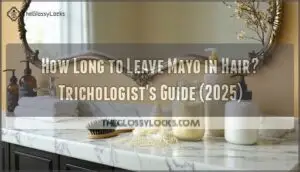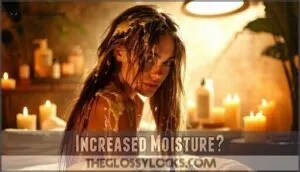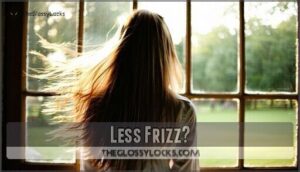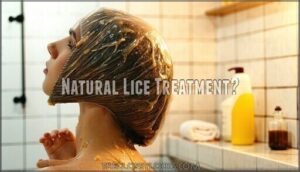This site is supported by our readers. We may earn a commission, at no cost to you, if you purchase through links.
 Your shower shelf already holds a dozen products promising softer hair, yet that jar of mayo in your fridge might outperform them all—if you know the right timing.
Your shower shelf already holds a dozen products promising softer hair, yet that jar of mayo in your fridge might outperform them all—if you know the right timing.
Most people who try mayonnaise hair treatments either wash it out too soon and see zero results, or leave it in so long their hair feels greasy for days.
The difference between a game-changing conditioning session and a slippery mess comes down to understanding how your specific hair type reacts to this pantry staple, and that window is narrower than you’d think.
Table Of Contents
- Key Takeaways
- How Long to Leave Mayo in Hair?
- Increased Moisture?
- Less Frizz?
- Stronger Hair?
- Hair Growth?
- Natural Lice Treatment?
- Application
- Frequently Asked Questions (FAQs)
- How often should I use a mayonnaise hair treatment?
- Does mayonnaise really help with hair growth?
- What ingredients should I look for in store-bought mayonnaise?
- Can I use mayonnaise to lighten my hair color?
- Are there any other ingredients I can add to mayonnaise for maximum benefit?
- Can mayonnaise cause scalp irritation or allergic reactions?
- Should you rinse with cold or hot water?
- Does mayo work on color-treated or bleached hair?
- Can you leave mayo in hair overnight safely?
- How often should you repeat mayo treatments weekly?
- Conclusion
Key Takeaways
- The optimal mayonnaise treatment duration is 20-30 minutes for most hair types, with fine hair requiring only 15-20 minutes to avoid heaviness while damaged or porous strands can tolerate 30-45 minutes for deeper conditioning benefits.
- Mayonnaise delivers genuine moisture retention and frizz control through its oil content and egg lecithin, which penetrate the hair shaft and seal the cuticle layer to prevent humidity penetration and environmental damage.
- The protein-rich formulation strengthens hair by filling microscopic gaps in damaged cuticles and preventing breakage, though it won’t accelerate actual follicular growth rates beyond the natural 0.5 inches per month.
- Application technique matters critically—use full-fat mayo on damp (not soaking) hair from mid-lengths to ends, secure under a plastic cap, and limit treatments to once weekly to avoid protein overload or greasy buildup.
How Long to Leave Mayo in Hair?
When you’re standing in your bathroom with a jar of mayo in hand, wondering if you’ve officially lost it or stumbled onto a hair-care secret, the answer matters: leave it in for 20 to 30 minutes for most hair types.
There’s actually science behind the 20-30 minute window—it’s where good conditioning meets healthy scalp practice.
If you’ve got fine hair, stick to 15-20 minutes so you don’t end up looking like you skipped wash day. Thicker, damaged, or porous hair? You can push it to 30-45 minutes and let those mayo treatment benefits really sink in.
The mayo hair care approach works because those oils and proteins need time to penetrate your cuticle without overwhelming it, giving you real hair mask benefits without the greasy aftermath.
Increased Moisture?
When you slather mayonnaise on your hair, you’re actually getting legitimate hydration—the high oil content works its way into each strand to replenish moisture, which makes a real difference if your hair’s been through the wringer.
Here’s how it works: lecithin from egg yolks grabs onto water molecules inside your hair while forming a fatty shield on the outside, so you get both immediate softness and moisture that actually sticks around.
Egg yolk lecithin bonds water inside your hair while creating a protective fatty layer outside, delivering instant softness and lasting moisture
And that vinegar? It’s not just for flavor—it brings your scalp’s pH back into balance, sealing in all that hydration and keeping your hair from turning brittle.
Here’s what this deep conditioning treatment offers:
- Emollient effects that combat dehydration from heat styling and environmental stress
- Hair conditioning and moisturizing through oils that smooth your cuticle layer
- Scalp balance from acidic ingredients that reduce flaking and irritation
- Hair mask benefits you’ll notice immediately—softer, more manageable strands
Consistent use transforms brittle hair into hydrated, resilient strands. For best results, consider using products that meet aesthetic industry standards.
Less Frizz?
If you’ve just hydrated your strands with a mayo mask, you’re probably wondering whether it’ll also tame that stubborn frizz—and the answer is yes, but the science behind it matters. The oils in your mayonnaise hair mask coat each strand to seal the cuticle layer, which stops moisture from escaping and humidity from penetrating—that’s your frizz control at work. This hair smoothing effect comes from fatty acids that create a protective barrier around damaged cuticles, giving you that smooth texture you’re after.
Three ingredients work together to lock in moisture and smooth down frizz:
Olive oil penetrates your hair shaft to tame flyaways while delivering essential moisturizing benefits. Vinegar balances your scalp’s pH to prevent the swelling that causes frizz. Egg lecithin binds moisture inside each strand for lasting hair treatment benefits.
You’ll notice silky locks after consistent use—your cuticles lay flat, reflecting more light and resisting environmental stress that triggers frizz.
Stronger Hair?
Beyond taming frizz, you’re probably looking for actual hair repair—and that’s where mayo’s protein benefits come into play. The egg-derived proteins in your mayo hair mask penetrate damaged hair shafts to reinforce structure from the inside out, which means you’ll see improved hair elasticity and fewer breaks when you brush or style.
That protein repair action works by filling microscopic gaps in your cuticles, creating a shield against heat styling and chemical treatments that usually weaken strands. Using a hair treatment with intensive conditioning properties can help repair and maintain healthy hair.
This simple treatment packs a real punch for your hair: the oils create a protective barrier around each strand, while proteins actually repair existing damage.
Brittle ends and splitting? That often points to protein deficiency—and applying it directly through your hair care routine makes a difference.
You won’t find extensive clinical studies yet, but the ingredient science is solid, and users with processed or damaged hair consistently report stronger, more resilient strands after regular mayo hair mask sessions.
Hair Growth?
The truth about hair growth and mayo masks? You won’t find peer-reviewed studies proving that mayonnaise accelerates how fast your hair follicle produces new strands—because your growth cycles run at roughly 0.5 inches per month regardless of what you slather on top. But here’s where things get interesting: mayo-based protein repair can dramatically improve hair retention by preventing breakage, which means you’ll keep more length over time.
Amino acids from eggs nourish your scalp and create better conditions for growth, while the moisturizing action prevents those tiny tears that undermine everything else you’re doing for your hair.
Think of it as damage control—you’re holding onto what’s already there, not triggering some magical growth spurt.
Clinical evidence shows that reducing breakage through deep conditioning leads to longer hair retention—not faster growth cycles, but better preservation of length. For persistent hair health and wellness concerns or actual follicle dysfunction, you’ll want professional guidance beyond home remedies, since mayo masks don’t contain pharmacologic agents that genuinely stimulate dormant hair repair mechanisms.
Natural Lice Treatment?
Can mayonnaise actually suffocate head lice? You’ll hear plenty of home remedies promising natural lice removal, but the clinical reality demands your attention. The theory hinges on suffocation—coating lice in thick mayo under a plastic cap for several hours or overnight—but lice can survive extended periods without air, and mayonnaise hair benefits don’t extend to killing nits.
One school-based study did report an 82% recovery rate within 6–8 days using mayonnaise hair masks, but the CDC doesn’t consider this treatment reliable or evidence-backed.
The real risks include bacterial contamination from raw egg content, potential allergic reactions, and the sheer messiness that makes consistent application nearly impossible.
More concerning? Mayonnaise hair treatment fails against lice eggs, meaning reinfestation cycles continue even after you’ve endured the greasy ordeal. FDA-approved topical treatments and proper combing deliver cure rates up to 100% in controlled trials—dramatically outperforming mayo-based hair mask approaches. For genuine scalp health and natural hair care, prescription pediculicides combined with mechanical nit removal remain your benchmark, not kitchen-cabinet experiments with natural oils.
Application
Proper application technique makes the difference between a salon-worthy treatment and a slippery disaster in your shower. Start with damp—not soaking—hair after shampooing, then work full-fat mayonnaise from mid-lengths to ends where damage concentrates. Your scalp doesn’t need this heavy treatment unless you’re battling severe dryness. Massage the mayo hair mask thoroughly, ensuring even distribution, then secure everything under a plastic cap to trap heat and boost penetration during your 20–30 minute treatment duration.
For best hair treatment and repair, limit mask frequency to once weekly. Fine hair requires 15-minute mayo timing, while porous textures benefit from 45-minute application tips.
Take control of your application with these game-changing tips:
- Use 2–4 tablespoons for shoulder-length hair—more wastes product and weighs you down
- Apply gentle heat with a warm towel for 5 minutes to boost ingredient absorption
- Rinse with lukewarm water first, then shampoo twice to eliminate all residue
Frequently Asked Questions (FAQs)
How often should I use a mayonnaise hair treatment?
Once a month works best for most hair types—it’s enough to strengthen and hydrate your strands without risking protein overload.
If you’ve got seriously damaged or color-treated hair, you can bump it up to twice monthly, but don’t overdo it or you’ll end up with limp, greasy locks.
Does mayonnaise really help with hair growth?
Think of it as fertilizer for your follicles—though the reality is more nuanced.
Mayonnaise hair masks offer protein repair and scalp health benefits through egg-derived peptides, which indirectly support hair growth by strengthening strands and improving texture.
The Mayo Nutrition won’t sprout new follicles, but this Hair Treatment can enhance conditions for healthier Hair Care outcomes.
What ingredients should I look for in store-bought mayonnaise?
Look for full-fat mayonnaise made with eggs, oil (soybean or canola works great), and either vinegar or lemon juice.
These ingredients deliver protein, fatty acids, and natural oils that condition your hair, while the acidity helps balance your scalp’s pH level.
Can I use mayonnaise to lighten my hair color?
Despite what some beauty blogs claim, mayonnaise won’t lighten your hair color—it’s not a bleach alternative or natural dye.
The eggs, oil, and vinegar hydrate color-treated hair but lack the chemical agents needed for color enhancement or toner effects, making this hair mask strictly a conditioning treatment.
Are there any other ingredients I can add to mayonnaise for maximum benefit?
You can boost your mayonnaise hair treatment by blending in olive oil, avocado, honey, coconut oil, or eggs.
These additions amplify hair moisturizing properties, improve texture, and support scalp health—transforming your DIY hair mask into a powerhouse treatment.
Can mayonnaise cause scalp irritation or allergic reactions?
Mayonnaise can definitely irritate your scalp or trigger allergic reactions if you’re sensitive to its ingredients.
The egg proteins and soybean oil in most mayo are common allergens that might lead to redness, itching, or contact dermatitis.
Always patch-test before full application to minimize risks.
Should you rinse with cold or hot water?
The right Water Temperature matters more than you’d think. Cool water seals your hair cuticle after your Mayo Hair Mask, locking in moisture and reducing frizz—especially for high Hair Porosity types.
Hot water strips your Conditioning Treatment benefits and may trigger Scalp Sensitivity, undermining your entire Hair Care Routine.
Does mayo work on color-treated or bleached hair?
Mayo works on color-treated or bleached hair, but use it cautiously. The acidic components can strip hair dye and alter toner effects, leading to faded shades.
For color-treated hair, keep your mayonnaise hair mask to 15-20 minutes max within your hair care routine.
Can you leave mayo in hair overnight safely?
Leaving mayo in your hair overnight? Not a great idea.
Studies show that extended treatments can lead to protein overload and irritate your scalp—two problems you definitely want to avoid.
Hair Mask Timing matters: overnight applications can cause Hair Damage Prevention issues, including brittleness and clogged follicles, undermining Mayonnaise Hair Treatment benefits.
How often should you repeat mayo treatments weekly?
For most people, a once-weekly Mayo hair treatment works best—your hair needs time between sessions to absorb protein without overload.
If you’ve got severely damaged strands, you can push to twice weekly initially, then scale back as your Hair Growth and texture improve.
Conclusion
Good things come to those who wait—but not for too long. Understanding how long to leave mayo in hair for hair treatment requires matching your patience to your porosity: fifteen minutes for fine strands, thirty for normal texture, forty-five for coarse or damaged locks.
Your hair’s transformation depends on respecting these boundaries, not pushing past them into greasiness. Skip the guesswork by testing a small section first, then commit to your timeline with confidence.
That mayo jar holds real potential once you stop treating every head of hair identically.








